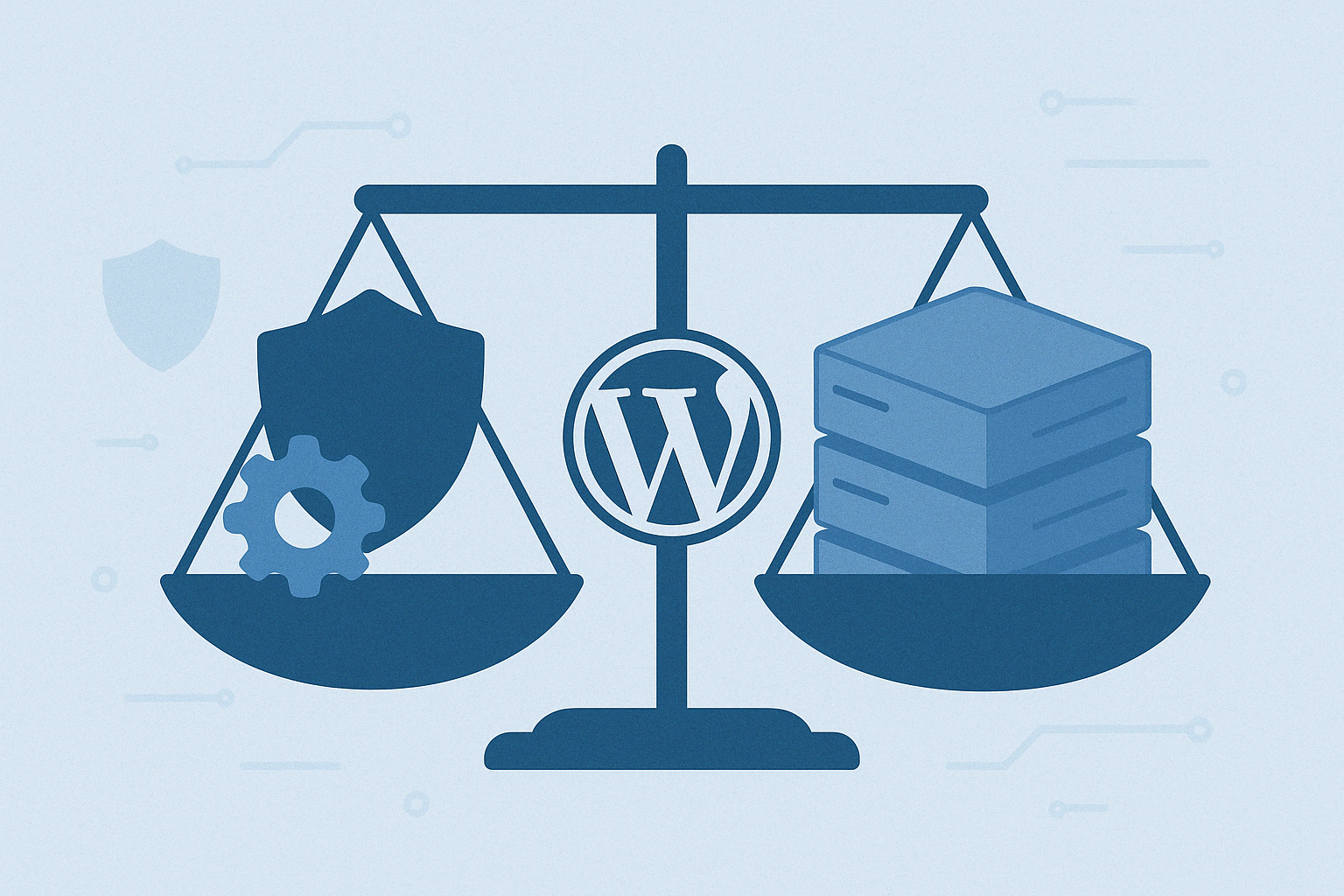WordPress Security vs Performance

At Trustdom, we've solved one of WordPress hosting's biggest challenges: keeping your site secure without sacrificing performance. Traditional WordPress hosting forces you to choose between security plugins that slow your site or fast sites that are vulnerable. We've built a platform where security is automatic, built-in, and actually improves performance.
Why Traditional WordPress Security Fails
- Performance penalty: Security plugins like Wordfence slow sites and consume more memory
- Security trade-offs: Fast sites skip essential security, leaving them vulnerable to attacks
- Maintenance burden: Constantly updating plugins, monitoring threats, and managing conflicts
- The Trustdom solution: Built-in security with read-only filesystems eliminates plugins while improving speed
Trustdom vs Traditional WordPress Security
| Approach | Traditional Hosting + Plugins | Trustdom's Built-in Security |
|---|---|---|
| Security Method | PHP plugins scanning every request | Read-only filesystem prevents attacks |
| Performance Impact | 21.5% slower with high memory usage | Zero performance penalty |
| Maintenance | Manual updates, conflicts, monitoring | Automatic security updates |
| Attack Prevention | Reactive detection after breach | Proactive prevention at infrastructure level |
How Trustdom Eliminates the Security vs Performance Trade-off
Traditional WordPress hosting forces you to compromise. You can have fast sites with minimal security, or secure sites that crawl under the weight of resource-heavy plugins. At Trustdom, we've eliminated this false choice entirely.
Our Built-in Security Architecture
Instead of bolting security onto WordPress after the fact, we've built it into our infrastructure:
Read-Only Filesystem
- Your WordPress files are on a read-only filesystem
- Attackers cannot inject code, even if they find vulnerabilities
- No performance impact - actually faster than writable filesystems
Git-Based Deployments
- All changes go through version control, not direct server edits
- You can install plugins and themes in the Trustdom dashboard; changes go through Git automatically
- Complete audit trail of every modification
- Instant rollback to any previous state
- Zero downtime deployments
Automatic WAF Protection
- Enterprise-grade Web Application Firewall built into our platform
- Blocks malicious traffic before it reaches your WordPress
- No plugins to slow down your site
Container Isolation
- Each WordPress site runs in its own isolated container
- Automatic updates without downtime
This approach delivers better security than any plugin while improving performance. Security plugins use PHP and consume server resources.
How Traditional Security Plugins Kill Performance
Security plugins can slow down your site by up to 21.50% [2]. Let’s break down how different security measures influence your site's speed and resource use, helping you weigh the balance between protection and performance.
Basic WordPress Security Tools
- SSL Certificates: Minimal overhead while offering encryption and SEO advantages.
- Lightweight Firewalls: When optimized, they add about 8 milliseconds to load times [3].
Speed Costs of Security Tools
Security plugins can impact your site's performance in significant ways:
| Security Plugin | Base Load Time / Memory | After Install Load Time / Memory | Performance Impact |
|---|---|---|---|
| Wordfence | 0.93 s | 1.13 s | 21.50% slower |
| iThemes Security | 89 MB RAM | 512 MB RAM | ~475% more RAM |
Best Practices for Balancing Speed and Security
- Choose hosting where security is built-in without plugins
- Use secure CDN and caching solutions
Strengthening Server Security
- Use SFTP for file transfers.
- Separate databases for each site.
- Server-level WAF.
- Disable file editing in WordPress:
define('DISALLOW_FILE_EDIT', true);
Kubernetes Hosting Benefits
Trustdom’s Kubernetes platform delivers both performance and security:
- Read-only filesystem
- Git-based deployments
- Automatic scaling
- Fully isolated environments
- BunnyCDN and Anycast DNS
Summary
Don’t use security plugins if you want the fastest possible site. Security plugins often weaken security too, because they carry vulnerabilities like other plugins. They also scan every request and consume server resources, slowing your site. Our platform builds security into the infrastructure itself:
Better Security:
- WordPress-optimized firewall at the CDN edge
- Read-only filesystem prevents code injection attacks that plugin-based protections can’t stop
- Container isolation stops lateral movement
- Git-based deployments provide complete audit trails and instant rollback
Superior Performance:
- Zero security plugins — no PHP scripts scanning every request
- Auto-scaling architecture handles traffic spikes seamlessly
- Global CDN integration delivers content faster than traditional caching plugins
- Optimized containers allocate resources based on actual demand
Benefits of security and speed
Google blacklists over 10,000 sites daily for security issues, while bounce rates rise sharply as load time increases from 1 second to 5 seconds. With Trustdom, you don’t have to choose between security and performance. You get both automatically, with less maintenance, better reliability, and lower total cost than plugin‑dependent hosting.
We’ve built the WordPress hosting platform that finally solves the security vs performance dilemma. Your sites run faster because they’re more secure, not despite it.
Ready to experience WordPress hosting without compromises? Explore our plans and see how read-only infrastructure can transform your WordPress security and performance.